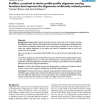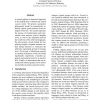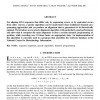120 search results - page 5 / 24 » How Much Can We Gain from Supervised Word Alignment |
BMCBI
2005
13 years 10 months ago
2005
Background: Profile-profile methods have been used for some years now to detect and align homologous proteins. The best such methods use information from the background distributi...
ACL
2010
13 years 8 months ago
2010
A central problem in historical linguistics is the identification of historically related cognate words. We present a generative phylogenetic model for automatically inducing cogn...
RECOMB
2001
Springer
14 years 10 months ago
2001
Springer
Hidden Markov models (HMMs) have been successfully applied to a variety of problems in molecular biology, ranging from alignment problems to gene nding and annotation. Alignment p...
KDD
2008
ACM
14 years 10 months ago
2008
ACM
Traditionally, research in identifying structured entities in documents has proceeded independently of document categorization research. In this paper, we observe that these two t...
JCB
2000
13 years 10 months ago
2000
For aligning DNA sequences that differ only by sequencing errors, or by equivalent errors from other sources, a greedy algorithm can be much faster than traditional dynamic progra...



